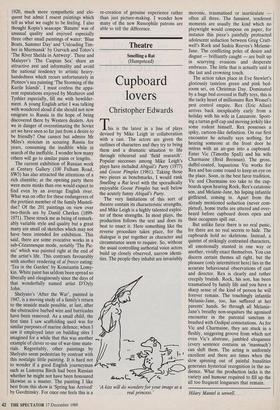ARTS
Exhibitions 1
The rush on Russian
Giles Auty
Russian Paintings (Roy Miles Fine Paintings, till 22 December) Russian Paintings (Century Gallery, till 20 February)
As the sound of cracking ice, result of the recent political thaw, reverberates around our hemisphere, we seem set to be deluged imminently with all things Rus- sian. Exhibitions of Russian art are likely to become commonplace as more and more Western entrepreneurs brave Rus- sian cuisine and climate to bring home the spoils. Will the next line of profitable imports be Russian army uniforms? A surplus of some half a million may come up for grabs during the coming months and could quickly become the latest street-cred fashion in Chelsea or Covent Garden.
This year there have been three com- mercial exhibitions of Russian paintings in London with several more lined up to break in the coming months. What should we conclude about them? From what I have seen so far there has been a bit too much evidence of the bland leading the bland, with honourable exceptions.
The large-scale exhibition organised by Roy Miles at 27 Berkeley Square, W1 is not lacking in pretension and includes a number of artists who were or are famous in the Soviet Union. Unavoidably one judges the art one sees with eyes which are more accustomed and attuned to West European painting. By such standards a lot of the art on view seems competent but lacking in sophistication; in short, the effects attempted are often sincere enough yet remain obvious or even clumsy. This is easiest to forgive when the subject matter is redeemed by an arresting strangeness. The husband-and-wife team of Leonid and Olga Tikhomirov work jointly on large, allegorical figure compositions and por- traits. I was taken rather with 'Peace to Your House', more from the unfamiliar yet believable nature of the wooden houses and haunting landscape than from a juve- nile lead seemingly unsure whether to pose as Christ or a springboard diver. By contrast, the Tikhomirovs' equally large and imposing painting 'Fates' bears down on one's consciousness with more obvious symbolism. I found Ivan Kopin's small watercolour entitled 'The Artist's Mother' 'Peace to Your House', by Leonid and Olga Tikhomirov 1920, much more sympathetic and elo- quent but admit I resent paintings which tell us what we ought to be feeling. I also thought Kopin's seascape 'Batumi' was of unusual quality and enjoyed especially three other small paintings of water: 'Blue Boats, Summer Day' and 'Unloading Tim- ber in Murmansk' by Gurvich and Totov's 'The River Shelda in Antwerp'. These and Maluyev's 'The Caspian Sea' share an attractive zest and informality and avoid the national tendency to artistic heavy- handedness which recurs unfortunately in Plotnov's sea painting 'The Storming of the Kurile Islands'. I must confess the appa- rent reputations enjoyed by Mezhirov and Tyshler especially, fill me with bewilder- ment. A young English artist I was talking with wondered aloud if she should not now emigrate to Russia in the hope of being discovered there by Western dealers. Are we in danger of overestimating the Soviet art we have seen so far just from a desire to be friendly? One cannot but admire Mr Miles's stoicism in scouring Russia for years, consuming the inedible while in search of the ineffable. I wonder how many others will go to similar pains or lengths.
The current exhibition of Russian work at Century Gallery (100 Fulham Road, SW3) has also attracted the attentions of a rich clientele; at the opening party there were more minks than one would expect to find even by an average English river. What was on offer for these endangerers of the prettiest member of the family Musteli- dae? Of the 201 paintings on view over two-thirds are by Daniil Cherkes (1899- 1971). These struck me as being of remark- ably variable style and quality but a great many are small oil sketches which may not have been intended for exhibition. This said, there are some evocative works in a sub-Cezannesque mode, notably 'The Pic- nic' which was painted right at the end of the artist's life. This contrasts favourably with another rendering of al fresco eating: 'Tea in the Garden' by Konstantin Lomy- kin. White paint has seldom been spread so liberally and oleaginously since the days of that wonderfully named artist D'Oyly John.
Shelyuto's 'After the War', painted in 1947, is a moving study of a family's return to the seaside made possible, at last, after the obstructive barbed wire and barricades have been removed. As a small child, the first time I saw scaffolding used was for similar purposes of marine defence; when I saw it employed later on building sites I imagined for a while that this was another example of clever re-use of war-time mate- rials. Regrettably, other paintings by Shelyuto seem pedestrian by contrast with this nostalgic little painting. It is hard not to wonder if a good English journeyman such as Lamorna Birch had been Russian whether he might not have been honoured likewise as a master. The painting I like best from this show is 'Spring has Arrived' by Gavdzinsky. For once one feels this is a re-creation of genuine experience rather than just picture-making. I wonder how many of the new Russophile patrons are able to tell the difference.



























































 Previous page
Previous page